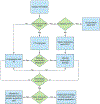Hemobilia: Etiology, diagnosis, and treatment☆
- PMID: 31308984
- PMCID: PMC6629429
- DOI: 10.1016/j.livres.2018.09.007
Hemobilia: Etiology, diagnosis, and treatment☆
Abstract
Hemobilia refers to bleeding from and/or into the biliary tract and is an uncommon but important cause of gastrointestinal hemorrhage. Reports of hemobilia date back to the 1600s, but due to its relative rarity and challenges in diagnosis, only in recent decades has hemobilia been more critically studied. The majority of cases of hemobilia are iatrogenic and caused by invasive procedures involving the liver, pancreas, bile ducts and/or the hepatopancreatobiliary vasculature, with trauma and malignancy representing the two other leading causes. A classic triad of right upper quadrant pain, jaundice, and overt upper gastrointestinal bleeding has been described (i.e. Quincke's triad), but this is present in only 25%-30% of patients with hemobilia. Therefore, prompt diagnosis depends critically on having a high index of suspicion, which may be based on a patient's clinical presentation and having recently undergone (peri-) biliary instrumentation or other predisposing factors. The treatment of hemobilia depends on its severity and suspected source and ranges from supportive care to advanced endoscopic, interventional radiologic, or surgical intervention. Here we provide a clinical overview and update regarding the etiology, diagnosis, and treatment of hemobilia geared for specialists and subspecialists alike.
Keywords: Diagnosis; Etiology; Hemobilia; Hepatopancreatobiliary interventions; Imaging; Upper gastrointestinal hemorrhage.
Conflict of interest statement
Conflict of interest The authors declare that they have no conflict of interest.
Figures





Similar articles
-
Hemobilia: Historical overview, clinical update, and current practices.Liver Int. 2019 Aug;39(8):1378-1388. doi: 10.1111/liv.14111. Epub 2019 May 3. Liver Int. 2019. PMID: 30932305 Review.
-
Hemobilia: Perspective and Role of the Advanced Endoscopist.Gastroenterol Res Pract. 2018 Jul 12;2018:3670739. doi: 10.1155/2018/3670739. eCollection 2018. Gastroenterol Res Pract. 2018. PMID: 30116262 Free PMC article. Review.
-
Hemobilia: An Uncommon But Notable Cause of Upper Gastrointestinal Bleeding.J Clin Gastroenterol. 2017 Oct;51(9):796-804. doi: 10.1097/MCG.0000000000000876. J Clin Gastroenterol. 2017. PMID: 28644311 Review.
-
Hemobilia: A Narrative Review of Current Diagnostic Techniques and Emerging Management Strategies.Cureus. 2024 Nov 4;16(11):e73009. doi: 10.7759/cureus.73009. eCollection 2024 Nov. Cureus. 2024. PMID: 39634971 Free PMC article. Review.
-
Revisiting Quincke's Triad: A Case of Idiopathic Hepatic Artery Aneurysm Presenting with Obstructive Jaundice.Ann Vasc Surg. 2021 Feb;71:536.e1-536.e4. doi: 10.1016/j.avsg.2020.09.057. Epub 2020 Nov 3. Ann Vasc Surg. 2021. PMID: 33157248
Cited by
-
Atypical Presentation of Left Hepatic Artery Pseudoaneurysm.ACG Case Rep J. 2022 Jul 1;9(7):e00815. doi: 10.14309/crj.0000000000000815. eCollection 2022 Jul. ACG Case Rep J. 2022. PMID: 35784506 Free PMC article.
-
Massive hemobilia caused by rupture of gastroduodenal artery pseudoaneurysm, a delayed complication of laparoscopic cholecystectomy: a case report.J Med Case Rep. 2021 Jul 2;15(1):331. doi: 10.1186/s13256-021-02915-1. J Med Case Rep. 2021. PMID: 34210350 Free PMC article.
-
Hemobilia and hemocholecyst as an unusual presentation of gallblader cancer: Report of a case.Int J Surg Case Rep. 2022 Oct;99:107712. doi: 10.1016/j.ijscr.2022.107712. Epub 2022 Sep 28. Int J Surg Case Rep. 2022. PMID: 36261947 Free PMC article.
-
Rare complications of chronic cholangitis: Pseudoaneurysm of the hepatic artery causing serious gastrointestinal bleeding.Radiol Case Rep. 2024 Jun 15;19(9):3688-3692. doi: 10.1016/j.radcr.2024.05.065. eCollection 2024 Sep. Radiol Case Rep. 2024. PMID: 38983296 Free PMC article.
-
Endoscopic Ultrasound-Guided Cholecystoenterostomy for Acute Hemorrhagic Cholecystitis Drainage.ACG Case Rep J. 2023 Jan 20;10(1):e00968. doi: 10.14309/crj.0000000000000968. eCollection 2023 Jan. ACG Case Rep J. 2023. PMID: 36699185 Free PMC article.
References
-
- Parekh J, Corvera CU. Hemorrhagic cholecystitis. Arch Surg 2010; 145: 202–204. - PubMed
-
- Bates D English manuscripts of Francis glisson (1): From anatomia hepatis (the anatomy of the liver), 1654. Andrew Cunningham. Isis 1996; 87: 357–358.
-
- Quincke H Ein fall von aneurysma der leberarterie. Berl Klin Wochenschr 1871; 30: 349–352.
-
- Sandblom P Hemobilia. Surg Clin North Am 1973; 53: 1191–1201. - PubMed
